"You can't have a light without a dark to stick it in." -Arlo Guthrie
You know the story. Every galaxy we look out at, with hardly any exceptions, appears to be moving away from us. Not only that, but the farther away a galaxy appears to be, the faster it appears to move away from us!
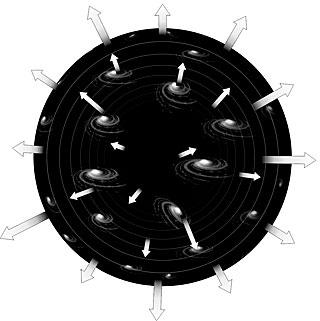
What do we observe that leads us to believe this? Well, thanks to Edwin Hubble, who looked at the spectra of distant galaxies, we discovered that, compared to Earth, where we make atoms emit and absorb light at very specific wavelengths (or frequencies):
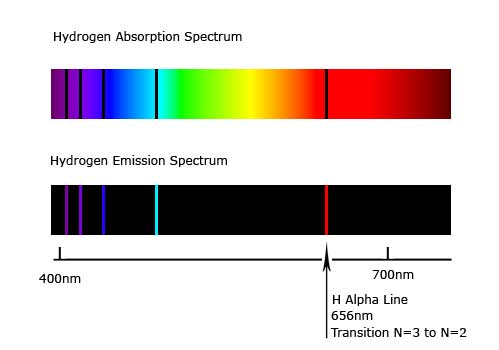
for distant galaxies, these emission/absorption lines are shifted towards the red! This means that they lose energy, somehow.

The standard interpretation is that these very distant galaxies are caught up in the expansion of the Universe! As the space between these galaxies increases, the wavelengths of the light emitted from them gets stretched, shifting them towards lower (redder) energies and wavelengths.
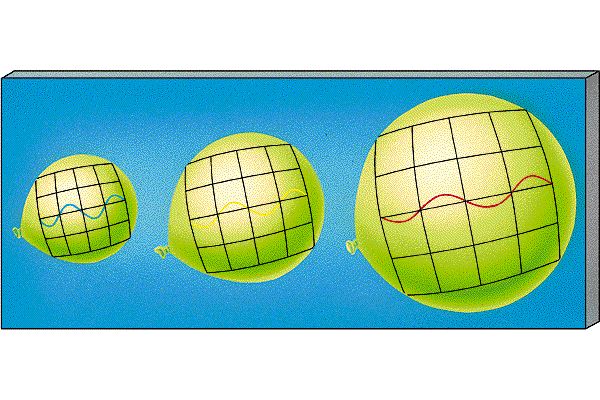
But we do make a large leap to go from that observation -- that the more distant an object is, the more redshifted it is -- to state that the Universe is expanding. Sure, it makes a wonderful picture that's very consistent with Hubble's Law, even when we look at galaxies and quasars a billion light years away!
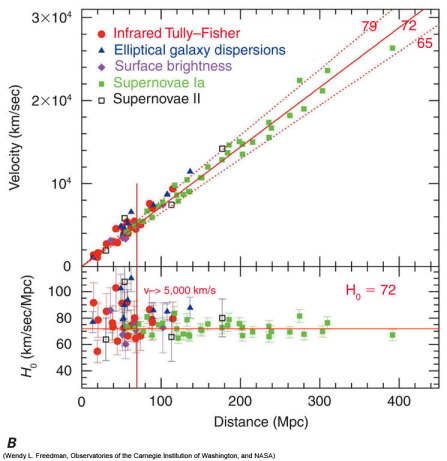
But that doesn't mean it's right.
One alternative is known as "tired light." In a Universe with tired light, each wave (or particle) of light loses energy, a little at a time, as it travels through space. The more space you travel through, the more energy you lose.
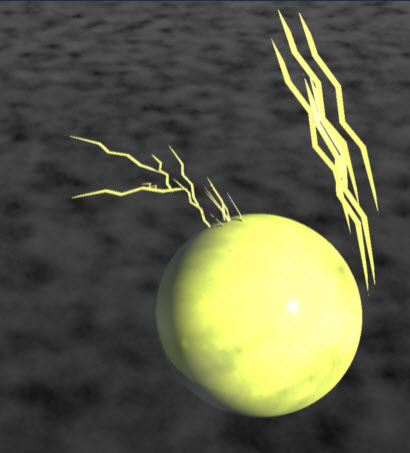
For light in our own galaxy, this is negligible, but for galaxies million (or billions) of light years away, this energy loss could add up, and could be an equally good explanation for why the Universe appears to have this distance-redshift relation.
But there's a huge problem with the idea of "tired light" for the Universe, observationally.

This is a map of the temperature fluctuations in the microwave background: the leftover glow from the Big Bang. It isn't coming from anywhere near us, so the only known explanation is that the Universe was once very, very hot -- so hot that you can't form neutral atoms -- and that it then expanded and cooled.
When we look out at the microwave sky, we see this microwave background nearly equally in all directions, at a temperature of 2.725 Kelvin.

Perhaps, you think to yourself, this is not a problem for tired light! After all, if these photons come from a long distance away, they'll cool down too. And by time they reach you, they could be at the same exact uniform temperature!
But although the temperature is right, the spectrum would be all wrong! Allow me to explain.
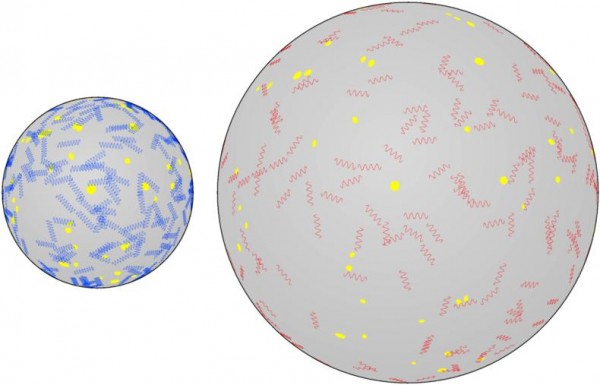
Image credit, for this and the next two images, courtesy of Ned Wright's fabulous Cosmology Tutorial. If you want a more technical treatment of tired light cosmology, you've got to check it out!
In the Big Bang, the photons cool down, but they also dilute as the Universe expands. In other words, as the Universe gets bigger (more volume), the number of light particles in a given region of space decreases (less density).
This type of expansion, in technical terms, is called either adiabatic (no heat loss) or isentropic (constant entropy). But what would we get in a tired-light Universe?

You can plainly see that if you start with a blackbody spectrum, and cool it down without expanding it, you end up with the wrong spectrum for your observed radiation!
So that's the simplest explanation of why tired-light doesn't work. Remember this when you look for alternatives to a scientific theory: it isn't enough to make a better explanation of some of the observations; you have to account for them all.

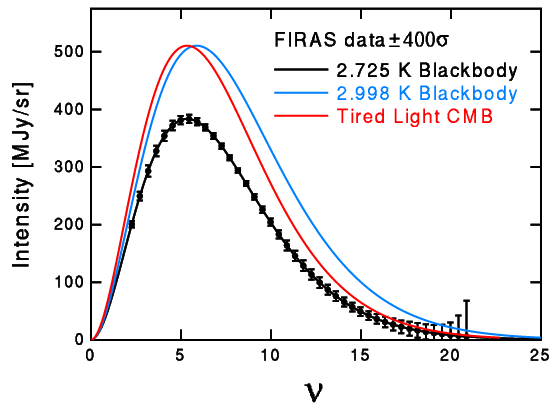
More fundamentally: doesn't the very existence of a hot early universe contradict the tired-light hypothesis? If the universe 14 billion years ago was the same size as it is now, where would that heat have gone between then and now?
This would make a great post imho. I would like to know your thoughts on the theory that time is slowing down. Allegedly this is causing the apparent redshift we are observing. This theory was proposed by Professor José Senovilla, Marc Mars and Raül Vera of the University of the Basque Country, Bilbao, and University of Salamanca, Spain.
A brief article below:
http://www.dailygalaxy.com/my_weblog/2010/07/is-time-disappearing-from-…
So the thing is, people need to keep studying and take the scientific attitude of provisional knowledge into themselves as a main guiding light. If you know a little science it may be worse than knowing no science, especially if you lack humility. This is actually true in most fields.
This thing about tired light is a really cool result, showing why the Big Bang survives the onslaught of skeptical thinking. This is not the only alternative explanation that has been presented over the time of its reign. The big bang may not have been actually proven beyond all doubt, but it is a really, really, really good guess. So many problems have been solved all up and down the time line and at all scales from stupendous macro to mini-micro. It is now hard to believe that it will not survive in some form. It has already been amended a few times, and one of them, inflation, is troublesome and awkward but the whole theory is far too valuable still.
But how do we know where the microwave background comes from? Hot early universe is one potential explanation but certainly not the only possibility.
Maybe CMB is the reason the light is getting "tired" - it could be that as light propagates in the intergalactic void some small portion of it's energy is being absorbed and re-emitted by something (dark matter, vacuum or spacetime fluctuations or something else we don't know yet) resulting in the CMB.
I have a question about the image with the balloon. If the wavelength of the light on the left is, say, 550 nm, then it looks like the scale, according to the grid is 1 unit =550 nm. On the right balloon the light is stretched, but so is the grid, so the wavelength is still 1 unit. It has always been explained to me that the expansion stretches everything, including our rulers (which is one reason gravitational wave detection is so difficult). If this is the case, then why don't we still measure the wavelength in the balloon on the right as 1 unit = 550 nm?
The CMB force is with us today.
Correct, but another problem is to sort out which predictions actually belong to a theory.
For example, the Nice model predicts _a whole lot_ of our solar system observations, and is part of a model set which predicts exoplanet system features as well. Now it turns out that the Kuiper belt double asteroids are, AFAIU, way too cool (too large orbits) to have come out of and/or survived the Nice planetary migration.
So there a layman stands, the scientists have a formidable model and it has a new problem, as it doesn't predict observed features. Or maybe it hasn't, perhaps something else caused them and _that_ mechanism should make the prediction. Time will tell.
@ crd2, Aran, Al:
It seems to me you consider the same problem in different guise. Presumably "tired time", change of local rulers, or CMB as "tiring light", would make the same rejected prediction as "tired light" on the global system CMB amplitude (intensity).
Aran, specifically space increasing doesn't mean non-gravitationally, mostly chemically, bounded systems like our bodies or our planets (aggregated by gravity, formed by its influence on hydrostatic equilibrium, but hold together by chemical cohesion forces) increase in size. Those sizes are specified by chemical energy, and their constance predicts "local rulers" stays the same. As they should do in special vs general relativity systems btw, AFAIU.
Al, the same supernova timing results on photons that tell us spacetime isn't granular on sub-Planck scales, or equivalently that Lorentz invariance holds on all scales, tells us there isn't any interaction leeching of energy. Those photons have not been messed with.
Now I'm sure as those results are considered not testing granularity in all cases and/or are rigorous enough (despite being 3 sigma observations AFAIU) by the professionals makes for loopholes. As well as a possible loophole of slight interaction, very few such photons were recorded at the time - but it should still predict all of CMB with your hypothesis, so there is something for you to check out.
But IMHO the standard theories at least make predictions, the simplest one at that, which granularity/interaction hypotheses have to reject outright despite current data seemingly testing the mentioned predictions. Forcibly, as extra-ordinary theories (together with the actual simplicity of the current physics and cosmology) needs extra-ordinary evidence.
@Torbjörn
"...Those sizes are specified by chemical energy..."
Chemical energy is EM energy, molecules are bound by EM forces so if expansion affects photons from distant sources it should also affect photons binding atoms into molecules and those molecules should expand as a result.
"...there isn't any interaction leeching of energy. Those photons have not been messed with."
They are redshifted so they definitely have been messed with and the energy has been leeched - this is an experimental fact. The question is what is responsible not if it happened.
With the advent of dark energy and dark matter now accounting for the vast majority of our universe, we must keep things in perspective by realizing that our "observed" universe now represents the exception rather than the rule. Perhaps it would help to spend as much time wondering why we can actually see such fine details on a small percentage of the distant universe at all as we do trying to figure out what it is that is we know is masked from us in some way.
In my totally unqualified opinion, I nevertheless suspect that waveform interference both positive and negative defines the stellarscape somewhat more than we currently suspect. Given billions of years over unfathomable distances, things are bound to happen, particularly when light diminishes in direct proportion to the cube of distance (or at least is supposed to). The available spectrum and photon density only survives the available waveform energy which is apparently quite variable. Time for my pill now.
Via Wien's law for black body radiation, the CMB temperature of 2.73 K is equivalent to the CPT violating antineutrino mass of 0.00117 eV, derived from the Koide formula from two phases: one universal = 2/9 and one Berry phase = pi/12 for noncommutative paths. This agrees with Riofrio's (or Penrose's) varying c cosmology, so tired light is definitely a dead idea.
Re #2: The idea that time is slowing down is untestable. If time slows down then anything you use to measure time will also slow down. So if what took one hour now takes two your clock will still tell you it took one hour. Also why would the wavelength of light from distant galaxies be the only thing unaffected by time slowing down?
This is probably a stupid question, but as I cannot think of a convincing answer, I´ll make it:
The distant galaxies have a big redshift and therefore are moving fast. But they also are seen further in the past, being younger as counting from the BB. The closer galaxies are moving slower but are older. So if things further in the past are faster and more recent ones are slower, why do we conclude that the the expansion of the universe is accelerating?
The tired light hypothesis was proposed in 1929 Zwicky. The largest redshift that Hubble measured in 1929 was z = 0.07. By the 1940's or so, scientists understood that the scattering mechanisms of the tired light hypothesis disallowed intergalactic dust scattering to explain the Hubble redshift; because it would give a smeared galactic image of distant galaxies; and no smearing is observed.
So why in 1960, when the furthest observed galaxies had a redshift of z = 0.46; and today when the furthest observed galaxy (IOK-1, 2006) has a redshift of z = 7; why do astronomers (Ethan)keep brow-beating the tired light theory???
And by the way, the CMB has a hypothetical redshift of z = 1000; and thus has nothing to do with Hubble's or todays observation of galaxies. It is an aspect of the "big bang theory" over and above the observed z = 7 redshift of the most distant observed galaxy. The z = 1000 (i.e. CMB) is not related to the z = 7 and lower z's of the observed galaxies of our visible universe.
70 years later, Ethan protesteth too much; unless the tired light theory might not really be dead. How so?
Certainly scattering by intergalactic dust is a dead theory; because there is no smearing of distant galactic images; but other mechanisms are possible. A general relativity gravitational redshift would not involve any smearing; because the effect of general relativity is due to the curvature of space. Yes think curvature of space not absorption by gravitons (a convenient psuedo-particle).
Let me propose an alternative theory by changing a few significant "assumptions" (while agreeing with all observed data) in various big bang theories.
*** First assume the strong cosmological principle rather than the weak cosmological principle. (This still allows a dynamic universe even without extra dimensions, but extra dimensions are preferred)
*** Next assume our visible universe is a 3-sphere (as both Einstein and Hubble assumed) rather than flat Euclidean; thus that our visible universe is only "apparently" expanding (as Hubble always preferred to say). (This does not contradict the recent WMAP data that the CMB is everywhere the same; but it does mean that the interpretation of the CMB due to inflation will not stand.)
*** Note that the strong cosmological principle with the 3-sphere assumption can creates a visible universe that is not gravitationally isotropic. Such a model universe can be rotating in more complex but similar way to Godel's universe.
Now in Godel's universe the rotation was of space relative to the galaxies. And this implied that in one direction, one would observe Hubble redshifts (with increasing distance); and in the other direction, one would observe Hubble blueshifts.
But in a multi-dimensional Universe in which our visible 3-sphere universe is a subuniverse; the rotation of our visible universe could always be away from the orthogonal extradimensions. Hence observations could all be consistently redshifted with increasing redshift until the event horizon of our visible universe of galaxies is reached. The necessity of extra-dimensions becomes more apparent every day. We can not stick with the once upon a time big bang model. It needs to be opened up not closed spatially. As well time needs to be more clearly define.
Why redshifted and not blueshifted? Why do the planet systems and galaxies and neutrinos all have a preferred direction of rotation? The redshift shows that our visible universe has a rotational handedness that is independent of direction. Of course rotation equals gravity (i.e. acceleration) equals redshift. It is OK for science to describe the handedness of a DNA molecule, neutrino spin, spiral galaxy spin and the visible universe rotation without being able to explain a common mechanism.
Now at the event horizon of black holes z = oo (theory); whereas the event horizon of our visible universe if CMB is such evidence is z = 1000. These two z's are more similar than the redshifts of z = 0.07 which Hubble saw in 1929, z = 0.46 seen in 1960 and z = 7 seen today.
If you make a simple Newtonian calculation (pg 36 to 39) with just enough special relativity to be honest; you will find that there is more than enough mass in the visible universe to account for Hubble's law without resorting to an expanding universe or even black holes and general relativity.
Galaxies do not speed away from one another; rather photons from distant galaxies ravitational time dilation dues to the intrinsic rotation of our visible universe.
Hows abouts a teensy-weensy bit of spacetime friction that would steal energy from the photon and simultaneously heat up the space time--causing spacetime BB emission and thermal expansion? (Note this is not trying to overturn expansion so much as the Dark Matter/Energy & Inflation trifecta of embarrassment.)
I think if we are willing to drop Conservation of Energy to let Dark Energy explain the observed acceleration, we ought to be equally willing to throw out CoE to let space-time either be an energy sink or source.
How does the light become "tired"?
So, what you're getting at is that the "tired light" is basically the particles of light that fade out, or can't reach far enough for it to shine really, is this correct or even remotely close?
Has anyone considered that cosmological observations could be explained by considering that the big-bang theory and tired light are both true?
Neden ve redshifted blueshifted deÄil mi? gezegen sistemleri ve galaksiler ve nötrino tüm dönme tercih edilen bir yön var mı neden? Kırmızıya kayma göstermektedir bizim görünür evrenin yönünden baÄımsız bir dönüŠellilik olduÄunu. Elbette rotasyon eÅittir ki yerçekimi (yani ivme) kırmızıya kayma eÅittir. Bilim ortak bir mekanizma açıklayabilecektir olmadan bir DNA molekülü, nötrino spin, spiral galaksinin spin ve görünür evrenin dönme ellilik tanımlamak için sorun deÄil.
It seems fantastic to me that the writer can claim the big bang model as conforming with observation when Dark matter and Dark energy are NOT OBSERVED. Talk about a board in your own eye
The theory that the redshift of light from different galaxies is cause as a result of the Doppler effect means that we have to deal with an extending universe in which the velocity of other galaxies are dependent on the distance thereof and unless the earth/sun is the origin of the universe imply that there must be a fourth dimension in which direction the origin of the universe should be. This is represented by the example of an expending balloon on which surface all the galaxies are situated.
Time wise this balloon should then go from very small at the beginning of the universe to very large the present situation. This lead then to the big bang theory. However we do not know if and how we can make any observations into this fourth dimension. Quantum physics has tried to describe this but according to Lee Smolin in his book “THE TROUBLE WITH PHYSICS” didn’t came to a very satisfying result.
However if we assume "tired light" due to the radiation of energy from a photon we get the same redshift as observe today but in this case the redshift is only dependent on the distance of those galaxies and we cannot say any thing more about the velocity or the acceleration of those galaxies. We are back to a three dimensional universe.
But this imply that we have to accept that the energy radiation of a photon also follows the “Stefan-Boltzmann Law”. As matter, quarks, leptons etc are all some form of energy this seems to be acceptable.
However the observations accepted by and theories based on an expanding universe have to be revalidated including the Big Bang theory.
Except ee have no mechanism to show actually happens with tired light.
We have verification of redshift.
And surely the dustier aread should be very tired, whilst the open intergalactic space relstively unfatigued.
hi
Te question of a mechanism for light losing energy on it's passage through space has been answered and demonstrated experimentally by the Shapiro effect. For a more complete explanation, see my website www.deceptiveuniverse.com.
http://www.worldsci.org/php/index.php?tab0=Scientists&tab1=Scientists&t…
The late physicist James Paul Wesley purposed a theory that explains how gravitational fields stretch out light frequencies with the lose of light energy translated into an increase in gravitational energy, his model explains the spectrum of the cosmic background radiation as light from the most distant stars. Dark matter is a denial of the falsification evidence against the big bang, it constitutes a supposition that evidence will be found in the future. a court of law would never convict on the basis of evidence assumed to be provided later, an accountant who promised to provide records later would not be trusted. Dark energy is a colossal falsification of the big bang turned into "proof" with a clever catchy term, these should be called dark evidence.
Speaking as a chemist and noting that there are about a million atoms per cubic metre of space, with varying densities in some regions, and also noting that almost everything in nature tends to have a simple explanation, I just can't get my head round why anything need be more complex than an infinite (more or less) non-expanding universe. If we assume that the photos travelling through space lose tiny amounts of energy, as they pass sufficiently close to each of the trillions of atoms and electrons on their journey towards us. That would result in a red shift proportional to the distance away from us. Further out photons will have lost their all visible light energy with their radiation instead now being in the microwave region. That would explain why: 1) we appear to be at the centre of the universe, 2) why the sky is dark rather than light, as might be expected in an infinite universe, and 3) why there is 3K background microwave radiation. Sounds too elegant not to be true!